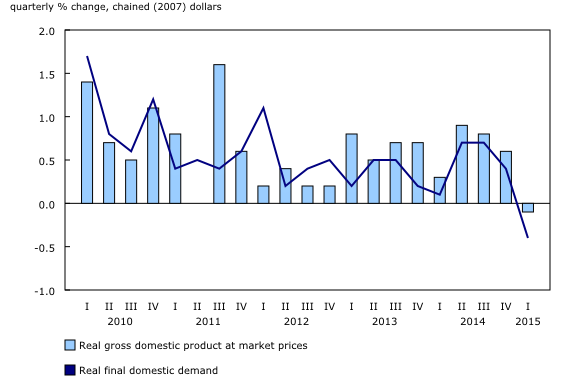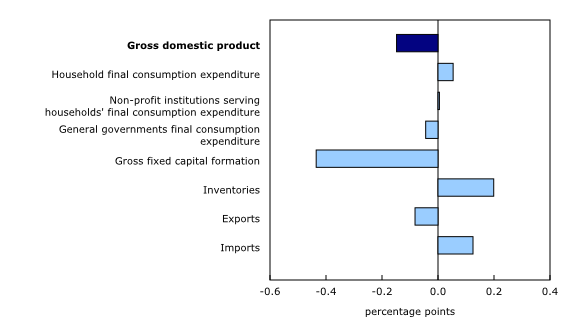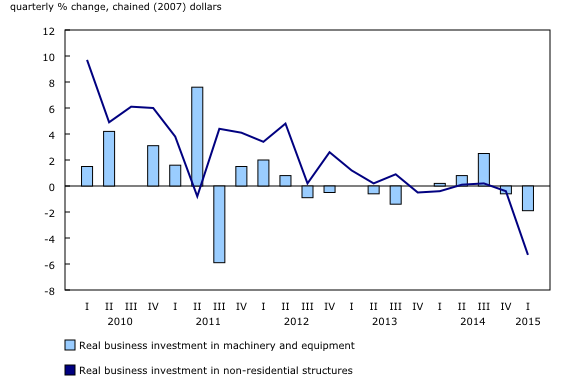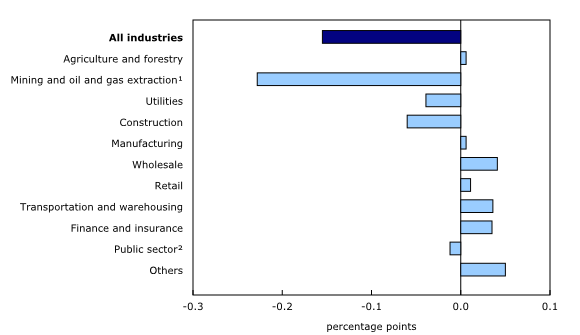Canadian economic accounts, first quarter 2015 and March 2015
Archived Content
Information identified as archived is provided for reference, research or recordkeeping purposes. It is not subject to the Government of Canada Web Standards and has not been altered or updated since it was archived. Please "contact us" to request a format other than those available.
Released: 2015-05-29
First quarter 2015
-0.6% 
(quarterly change, annualized)
Real gross domestic product (GDP) decreased 0.1% in the first quarter, following growth of 0.6% in the fourth quarter of 2014. This was the first negative growth rate of real GDP since the second quarter of 2011. On a monthly basis, real GDP by industry fell 0.2% in March.
Final domestic demand fell 0.4% after increasing 0.4% in the previous quarter.
Business gross capital formation was down 2.5%, driven by a 4.1% decrease in non-residential structures and machinery and equipment. On the other hand, business investment in residential structures was up 1.0%, led by an increase in new home construction.
Household final consumption expenditure rose 0.1%, the smallest gain since the second quarter of 2012. Increased outlays on semi-durable and non-durable goods more than offset decreased spending on durable goods. Growth in expenditures on services slowed to 0.1%.
Government final consumption expenditure was 0.2% lower.
Businesses added $11.6 billion to their inventories in the first quarter, up from $8.5 billion in the previous quarter. Wholesalers increased their inventories of durable goods by $7.1 billion.
Exports of goods and services decreased 0.3%, following a 0.4% decline in the previous quarter. Exports of goods declined 0.5%, while services increased 0.8%. Imports of goods and services fell 0.4%.
The value added of goods-producing industries decreased 1.0% in the first quarter, while that of service industries rose 0.2%.
The mining, quarrying and oil and gas extraction sector posted a notable decrease in the first quarter, as a result of a 30% decline in support activities for mining and oil and gas extraction. Construction, wholesale trade and manufacturing posted notable declines as well. There were also decreases in accommodation and food services, transportation and warehousing services and in the output of real estate agents and brokers. On the other hand, the finance and insurance sector, utilities as well as the agriculture and forestry sector increased in the first quarter. The public sector and professional services also advanced.
Expressed at an annualized rate, real GDP contracted 0.6% in the first quarter. By comparison, real GDP in the United States rose 0.2% (advance estimate).
Household spending slows
Household final consumption expenditure grew 0.1% in the first quarter. Nonetheless, this was the slowest growth in household spending since the second quarter of 2012. A decline in durable goods (-1.4%) was offset by increases in semi- (+0.3%) and non-durable goods (+0.7%). Outlays on services edged up 0.1%.
Following nine quarters of growth, expenditures on transport fell by 0.6% as a result of a decline in purchases of vehicles (-3.0%). Spending on housing, water, electricity, gas and other fuels advanced 1.1%.
Expenditures by Canadians abroad fell by 5.6%, after declining 1.0% in the fourth quarter of 2014.
Business outlays on plant and equipment drop
Business gross fixed capital formation in non-residential structures and machinery and equipment fell 4.1% in the first quarter, the largest decrease since the second quarter of 2009. Business investment in non-residential structures declined 5.3%, driven by decreased outlays on engineering structures (-6.4%).
Investment in machinery and equipment decreased 1.9%, the second quarterly decline. Industrial machinery and equipment (-2.9%) and medium and heavy trucks, buses and other motor vehicles (-3.2%) were the main contributors to the decrease. On the other hand, outlays on aircraft and other transportation equipment (+3.3%) were higher.
Housing investment strengthens
Business gross fixed capital formation in residential structures increased 1.0% in the first quarter, following 0.1% growth in the fourth quarter of 2014. The increase stemmed from new housing construction (+3.5%) and renovations (+0.3%). Ownership transfer costs (-3.2%) were down for a second consecutive quarter, reflecting continued weakness in housing resale activity.
Acceleration in business inventory accumulation continues
Businesses added $11.6 billion to inventories in the first quarter, compared with $8.5 billion in the fourth quarter of 2014.
Wholesalers added significantly to their stocks of durable and non-durable goods during the first quarter (+$8.0 billion) compared with an accumulation (+$3.9 billion) in the fourth quarter of 2014. Manufacturers' inventories increased $3.7 billion, mostly in durable goods. Farm inventories declined by $398 million, the fifth consecutive quarterly decrease, as grain holdings were sold off.
In contrast to wholesalers and manufacturers, retailers reduced their inventories by $1.2 billion, as a result of a drawing down of inventories of motor vehicles. This was the largest reduction in retail trade inventories since the second quarter of 2013.
Exports fall
Exports of goods and services (-0.3%) fell for the second quarter in a row, following a 0.4% decline in the fourth quarter of 2014.
Exports of goods were down 0.5%, compared with a 0.7% decline in the previous quarter. Exports of motor vehicles and parts fell 5.9%, a second consecutive quarterly decline, mainly due to lower exports of passenger cars and light trucks. Exports of metal and non-metallic mineral products (-7.0%) and consumer goods (-2.0%) also declined after four consecutive quarters of positive growth.
These declines were mitigated by gains in exports of energy products (+4.2%), metal ores and non-metallic minerals (+4.6%), forestry products and building and packaging materials (+2.2%) and farm, fishing and intermediate food products (+1.9%).
Service exports advanced 0.8%, following a 1.1% increase in the previous quarter. Higher exports of commercial (+0.9%) and travel (+0.3%) services contributed to the gain. Transportation and general governments services were also higher.
Imports decline
Imports of goods and services fell 0.4% after three consecutive quarters of positive growth. Motor vehicles and parts (-3.6%), metal and non-metallic mineral products (-3.7%), metal ores and non-metallic minerals (-8.6%) and consumer goods (-0.6%) were the main contributors to the decline.
Lower imports of tires, motor vehicle engines and parts (-4.3%) were the main contributors to the decline of imports of motor vehicles and parts.
On the other hand, imports of energy products rose 8.1%, a third consecutive quarterly increase. Higher imports of electronic and electrical equipment and parts (+2.8%) were driven by increased imports of communications and audio and video equipment.
Service imports decreased 0.8%, following a 0.6% increase in the previous quarter, driven by declines in travel (-3.4%) and general governments services (-5.5%). Imports of commercial (+0.6%) and transportation (+0.4%) services went up.
Weaker terms of trade
The terms of trade deteriorated for the fourth quarter in a row, as export prices fell whereas import prices increased. As a result, real gross domestic income decreased 1.2% in the first quarter, compared with a 0.1% decline in the fourth quarter of 2014.
Export prices declined 2.2%, while import prices were 1.1% higher. The overall price of goods and services produced in Canada fell 0.5%, compared with a 0.4% decline in the fourth quarter of 2014, a second consecutive quarterly drop.
The price of final domestic demand grew 0.5%, following a 0.4% increase in the previous quarter.
Economy-wide income falls
Nominal GDP decreased 0.7% in the first quarter after gaining 0.1% in the previous quarter. This was the first decrease since the second quarter of 2009.
The large decline in energy prices had a significant effect on economy-wide incomes and expenditures in the quarter. While nominal GDP fell 0.7% in the quarter, GDP excluding expenditures on energy products increased 0.3%. In real terms, the opposite occurred. While total real GDP fell 0.1%, real GDP excluding expenditure on energy products fell 0.2%.
Compensation of employees rose 1.1% following a 0.5% gain in the fourth quarter of 2014. Wages and salaries in services-producing industries grew by 1.2% while in goods-producing industries they fell 0.2%.
Gross operating surplus of non-financial corporations continued to decline, posting a 6.8% decrease in the first quarter following a 1.3% decline in the previous quarter. Similarly, the gross operating surplus of financial corporations fell 1.5% in the first quarter after declining 2.9% in the previous quarter.
Household saving rate increases
The household saving rate rose to 5.0% in the first quarter, up from a rate of 3.6% in the fourth quarter of 2014.
The household debt service ratio, defined as household mortgage and non-mortgage interest paid divided by household disposable income, fell to 6.74%, the lowest level since being first recorded in 1990.
The national saving rate declined to 3.5%, as national net saving fell from the previous quarter. This was the lowest level since the third quarter of 2010.
Gross domestic product by industry, March 2015
Real gross domestic product fell 0.2% in March, down for a third consecutive month. A contraction in the output of goods-producing industries outweighed an overall increase in the output of service industries.
Goods production contracted 1.0% in March, down for a third consecutive month, primarily as a result of declines in mining, quarrying, and oil and gas extraction and, to a lesser extent, construction. Decreases were also posted in utilities. In contrast, the agriculture and forestry sector rose while manufacturing edged up.
The output of service-providing industries increased 0.2% in March, after edging up 0.1% in February. Increases were notable in wholesale trade, the finance and insurance sector as well as transportation and warehousing services. Retail trade was also up. Conversely, accommodation and food services declined and the public sector (education, health and public administration combined) edged down.
Mining, quarrying, and oil and gas extraction falls again
Mining, quarrying, and oil and gas extraction contracted 2.6% in March, down for a fifth consecutive month. Oil and gas extraction as well as support activities for mining and oil and gas extraction fell, while mining excluding oil and gas extraction increased.
After rising 2.3% in January and edging up 0.1% in February, oil and gas extraction decreased 2.3% in March, as a result of declines in both conventional crude petroleum and non-conventional oil extraction.
Support activities for mining and oil and gas extraction fell 17% in March, as both drilling and rigging services retreated. This follows contractions of 15% in January and 19% in February.
Mining and quarrying (excluding oil and gas extraction) grew 0.8% in March. An increase in metallic mineral mining, primarily copper, nickel, lead and zinc, outweighed a decline in potash mining.
Construction decreases
Construction declined 0.8% in March, down for a fifth consecutive month. Declines in engineering and, to a lesser degree, non-residential building construction outweighed increases in residential building and repair construction.
The output of real estate agents and brokers rose 3.7% in March, after increasing 2.6% in February.
Wholesale and retail trade rise
Wholesale trade rose 0.8% in March, primarily as a result of increases in the wholesaling of building materials and supplies and, to a lesser extent, food, beverage and tobacco products. The wholesaling of personal and household goods as well as motor vehicles and parts also increased. March's growth follows declines of 2.5% in January and 1.0% in February. In contrast, the activities of machinery, equipment and supplies wholesalers, miscellaneous wholesalers as well as of petroleum products wholesaler-distributors were down.
After rising 1.4% in February, retail trade grew 0.2% in March on the strength of food and beverage stores, clothing and clothing accessories stores and health and personal care stores. Growth was mitigated by declines in activities at general merchandise stores, gasoline stations and motor vehicles and parts dealers.
Manufacturing output edges up
Manufacturing output edged up 0.1% in March.
Non-durable goods manufacturing edged up 0.1% in March. Increases in the manufacturing of petroleum and coal products, paper and food outweighed declines in the manufacturing of chemical as well as textile, clothing and leather products.
After declining 1.5% in January and 2.6% in February, durable-goods manufacturing was unchanged in March. The manufacturing of transportation equipment, notably motor vehicle and ship and boat building manufacturing, was up. In contrast, the manufacturing of fabricated metal products, of machinery and of computer and electronic products was down.
Finance and insurance sector rises
The finance and insurance sector rose 0.5% in March following a 0.8% increase in February. Banking and financial investment services increased in March.
Other industries
Utilities decreased 1.6% in March, after increasing in both January and February. Electricity generation, transmission and distribution as well as natural gas distribution were down, partly a result of warmer than usual temperatures in March in some parts of the country.
The public sector (education, health and public administration combined) edged down 0.1%.
Products, services and contact information
Detailed analysis and tables
The System of macroeconomic accounts module, accessible from the Browse by key resource module of our website, features an up-to-date portrait of national and provincial economies and their structure.
The paper "Gross Domestic Product Excluding Expenditures on Energy Related Products" is now available, as part of Income and Expenditure Accounts Technical Series (13-604-M).
Links to other releases from the national accounts can be found in the first quarter 2015 issue of Canadian Economic Accounts Quarterly Review, Vol. 14, no. 1 (13-010-X). This publication is now available from the Browse by key resource module of our website under Publications. This publication will be updated on June 12, at the time of the release of the national balance sheet and financial flow accounts.
Note to readers
For more information on seasonal adjustment, see Seasonally adjusted data – Frequently asked questions.
Percentage changes for expenditure-based and industry-based statistics (such as personal expenditures, investment, exports, imports and output) are calculated from volume measures that are adjusted for price variations. Percentage changes for income-based and flow-of-funds statistics (such as labour income, corporate profits, mortgage borrowing and total funds raised) are calculated from nominal values; that is, they are not adjusted for price variations.
There are four ways of expressing growth rates for gross domestic product (GDP) and other time series found in this release.
1. Unless otherwise stated, the growth rates of all quarterly data in this release represent the percentage change in the series from one quarter to the next, such as from the fourth quarter of 2014 to the first quarter of 2015.
2. Quarterly growth can be expressed at an annual rate by using a compound growth formula, similar to the way in which a monthly interest rate can be expressed at an annual rate. Expressing growth at an annual rate facilitates comparisons with official GDP statistics from the United States. Both the quarterly growth rate and the annualized quarterly growth rate should be interpreted as an indication of the latest trend in GDP.
3. The year-over-year growth rate is the percentage change in GDP from a given quarter in one year to the same quarter one year later, such as from the first quarter of 2014 to the first quarter of 2015.
4. The growth rates of all monthly data in this article represent the percentage change in the series from one month to the next, such as from February to March 2015.
Products
Gross domestic product by industry
Data on gross domestic product by industry for April will be released on June 30.
Gross domestic product by income and by expenditure accounts
Data on gross domestic product for the first quarter of 2015 have been released along with revised data for the first, second, third and fourth quarters of 2014. These data incorporate new and revised source data and updated data on seasonal patterns.
Data on gross domestic product by income and by expenditure for the second quarter will be released on September 1. For more information, consult the Guide to the Income and Expenditure Accounts (13-017-X).
Contact information
For more information, or to order data, contact us (toll-free 1-800-263-1136; 514-283-8300; infostats@statcan.gc.ca).
To enquire about the concepts, methods or data quality of this release, contact Allan Tomas (613-790-6570), Industry Accounts Division.
For more information, or to enquire about the concepts, methods or data quality of this release, contact us (toll-free 1-800-263-1136; 514-283-8300; infostats@statcan.gc.ca) or Media Relations (613-951-4636; statcan.mediahotline-ligneinfomedias.statcan@canada.ca).
- Date modified:






